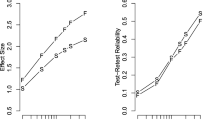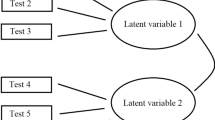Abstract
Studies of autism typically adopt a factorial matched-groups design aimed at eliminating nonspecific factors such as mental retardation as explanations of performance on experimental tasks. This paper reviews the issues involved in designing such studies and interpreting their results and suggests that the best approach to matching may be to equate performance on carefully designed control tasks. However, we also argue that the interpretation of such studies is often complicated by the fact that associations between background measures and experimental task performance are not clear. Consequently, we also advocate the use of regression techniques that allow the researcher to determine the factors that relate to task performance and to assess the extent of group differences on the task of interest having taken these factors into account.
Similar content being viewed by others
Reference
Anderson, M. (1992). Intelligence and development: A cognitive theory. Oxford: Blackwell.
Anderson, M. (2001). Conceptions of intelligence. Journal of Child Psychology and Psychiatry, 42, 287-298.
Baddeley A., & Gathercole, S. (1999). Individual differences in learning and memory: Psychometrics and the single case. In P. L. Ackerman, P. C. Kyllonen, & R. D. Roberts (Eds.), Learning and individual differences (pp. 31-50). Washington, DC: American Psychological Association.
Baddeley A., Gathercole S., & Papagno, C. (1998). The phonological loop as a language learning device. Psychological Review, 105, 158-173.
Baron-Cohen, S. (1995). Mindblindness: An essay on autism and theory of mind. Cambridge, MA: MIT Press/Bradford Books.
Bishop, D. V. M. (1997). Cognitive neuropsychology and developmental disorders: Uncomfortable bedfellows. Quarterly Journal of Experimental Psychology, 50A, 899-923.
Brock J., McCormack T., & Boucher, J. (2003). The relationship between phonological short-term memory and vocabulary knowledge in Williams syndrome.
Burack, J. A. (1990). Differentiating mental retardation: The twogroup approach and beyond. In R. M. Hodapp, J. A. Burack, & E. Zigler (Eds.), Issues in the developmental approach to mental retardation (pp. 27-48). Cambridge: Cambridge University Press.
Burack, J. A., Iarocci G., Bowler D., & Mottron, L. (2002). Benefits and pitfalls in the merging of disciplines: The example of developmental psychopathology and the study of persons with autism. Development and Psychopathology, 14, 225-237.
Chapman, R. S. (1997). Language development in children and adolescents with Down syndrome. Mental Retardation and Developmental Disabilities Research Reviews, 3, 307-312.
Charman, T. (1994). Brief report: An analysis of subject characteristics in research reported in the Journal of Autism and Developmental Disorders 1982–1991. Journal of Autism and Developmental Disorders, 24, 209-213.
Cronbach, L. J. (1957). The two disciplines of scientific psychology. American Psychologist, 12, 671-684.
Evans, S. H., & Anastasio, E. J. (1968). Misuse of analysis of covariance when treatment effect and covariate are confounded. Psychological Bulletin, 69, 225-234.
Fein D., Lucci D., Braverman M., & Waterhouse, L. (1992). Comprehension of affect in context in children with pervasive developmental disorders. Journal of Child Psychology and Psychiatry, 33, 1157-1167.
Frith U., Morton, J. A., & Leslie, A. M. (1991). The cognitive basis of a biological disorder: Autism. Trends in Neurosciences, 14, 433-438.
Happé, F. G. E. (1994). Wechsler I.Q. profile and theory of mind in autism: A research note. Journal of Child Psychology and Psychiatry, 35, 1461-1471.
Happé, F. G. E. (1995). The role of age and verbal ability in the theory of mind task performance of subjects with autism. Child Development, 66, 843-855.
Hobson, R. P. (1991). Methodological issues for experiments on autistic individuals' perception and understanding of emotion. Journal of Child Psychology and Psychiatry, 32, 1135-1158.
Huitema, B. E. (1980). The analysis of covariance and alternatives. New York: Wiley.
Hulme C., & Roodenrys, S. (1995). Practitioner review: Verbal working memory development and its disorders. Journal of Child Psychology and Psychiatry, 36, 373-398.
Jarrold C., Boucher J., & Russell, J. (1997). Language profiles in children with autism: Theoretical and methodological implications. Autism, 1, 57-76.
Jarrold C., Baddeley, A. D., & Hewes, A. K. (1999). Genetically dissociated components of working memory: Evidence from Down's and Williams syndrome. Neuropsychologia, 37, 637-651.
Jarrold C., Baddeley A., & Phillips, C. E. (2002). Verbal short-term memory in Down syndrome: A problem of memory, audition, or speech? Journal of Speech, Language, and Hearing Research, 45, 531-544.
Jarrold C., Butler, D. W., Cottington, E. M., & Jimenez, F. (2000). Linking theory of mind and central coherence bias in autism and in the general population. Developmental Psychology, 26, 126-138.
Joseph, R. M., Tager-Flusberg H., & Lord, C. (2002). Cognitive profiles and social-communicative functioning in children with autism spectrum disorder. Journal of Child Psychology and Psychiatry, 43, 807-821.
Kjelgaard, M. M., & Tager-Flusberg, H. (2001). An investigation of language impairment in autism: Implications for genetic subgroups. Language and Cognitive Processes, 16, 287-308.
Klein, B. P., & Mervis, C. B. (1999). Cognitive strengths and weaknesses of 9-and 10-year-olds with Williams syndrome or Down syndrome. Developmental Neuropsychology, 16, 177-196.
Miller, G. A., & Chapman, J. R. (2001). Misunderstanding analysis of covariance. Journal of Abnormal Psychology, 110, 40-48.
Ozonoff S., Pennington, B. F., & Rogers, S. J. (1990). Are there emotion perception deficits in young autistic children? Journal of Child Psychology and Psychiatry, 31, 343-361.
Phillips, C. E., Jarrold C., Baddeley A., Grant J., & Karmiloff-Smith, A. (2003). Comprehension of spatial language terms in Williams syndrome: Evidence for an interaction between domains of strength and weakness. Cortex.
Prior, M. R. (1979). Cognitive abilities and disabilities in infantile autism: A review. Journal of Abnormal Child Psychology, 7, 357-380.
Robinson, W. S. (1950). Ecological correlations and the behavior of individuals. American Sociological Review, 15, 351-357.
Ropar D., & Mitchell, P. (2001). Susceptibility to illusions and performance on visuo-spatial tasks in individuals with autism. Journal of Child Psychology and Psychiatry, 42, 539-549.
Russell J., Jarrold C., & Henry, L. (1996). Working memory in children with autism and with moderate learning difficulties. Journal of Child Psychology and Psychiatry, 37, 673-686.
Spitz, H. H. (1982). Intellectual extremes, mental age, and the nature of human intelligence. Merrill-Palmer Quarterly, 28, 167-192.
Strauss, M. E. (2001). Demonstrating specific cognitive deficits: A psychometric perspective. Journal of Abnormal Psychology, 110, 6-14.
Thomas, M. S. C., Grant J., Barham Z., Gsödl, M. K., Laing E., Lakusta L., et al. (2001). Past tense formation in Williams syndrome. Language and Cognitive Processes, 16, 143-176.
Turner, M. (1997). Towards an executive dysfunction account of repetitive behavior in autism. In J. Russell (Ed.), Autism as an executive disorder (pp. 57-100). Oxford: Oxford University Press.
Weiss B., Weisz, J. R., & Bromfield, R. (1986). Performance of retarded and nonretarded persons on information-processing tasks: Further tests of the similar structure hypothesis. Psychological Bulletin, 100, 157-175.
Author information
Authors and Affiliations
Corresponding author
Rights and permissions
About this article
Cite this article
Jarrold, C., Brock, J. To Match or Not to Match? Methodological Issues in Autism-Related Research. J Autism Dev Disord 34, 81–86 (2004). https://doi.org/10.1023/B:JADD.0000018078.82542.ab
Issue Date:
DOI: https://doi.org/10.1023/B:JADD.0000018078.82542.ab




